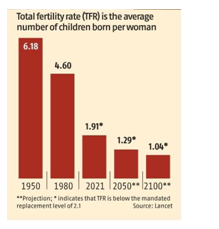

Context
India’s total fertility rate (TFR) is projected to decline to 1.29 children per woman by 2050 and slip further to 1.04 by 2100, according to a recent study by Lancet on global fertility rates.
Key-findings of the Lancet Study
- The study suggests that India’s TFR, or the average number of children born to a woman, has been seeing a decline over the last century, with the fertility rate falling from 6.18 children per woman in 1950 to a projected 1.29 children per woman by 2050.
- The study stated that India has already fallen below the replacement level of fertility, required for a population to exactly replace one generation with another.
- In 2021, India’s TFR was at 1.91 children per woman, below the necessary replacement fertility level of 2.1.
- The decline in TFR is in line with global trends, stating that its estimates forecast a decline in fertility rates all around the globe, over the coming century.
1: Dimension-Reasons behind the fall in the fertility rate
- Delayed marriages: With the delay in the age of marriage, the average age of first pregnancy has dropped from the mid-20’s to mid to late 30’s.
- Women’s workforce participation: An increase in female literacy and women’s workforce participation leads to busy lifestyles in urban areas and high stress jobs. It leads people to not consider having children at all.
- Other factors: The decline in fertility rates is also influenced by factors such as extreme shifts in the global distribution of live births due to:
- improved female education
- increasing usage of modern contraception methods
2: Dimension-Implications for the Economy
- Imbalance: Such a trend will pose challenges such as an ageing population, labour force shortages, and potential social imbalances due to gender preferences in the country.
- Burdened economy: The plummeting fertility rate in developed or high-income countries may result in an ageing population, burdening national health insurance, social security programmes, and healthcare infrastructure.
- Political instability and security difficulties: While the declining fertility rates might appear as a green signal for the environment, the uneven concentration of live births can lead to tense situations across the globe.
3: Dimension-Required Measures
- Economic policies that stimulate growth and job creation, alongside social security and pension reforms are essential in adapting to and mitigating the impacts of declining fertility rates.
- Higher male engagement in household activities: For women to be able to manage careers with motherhood, it would be crucial for men to take greater responsibility for household and care work.
|
Fact Box: Replacement Level
|


